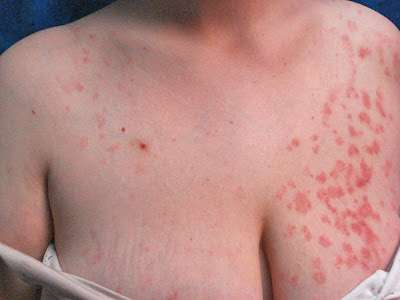HPI: Her dermatitis began with a single erythematous plaque on the left breast. Within one to two weeks, it spread to the present extent (almost all was on the upper chest and breast). She had used a topical imidazole cream without relief. No new medications.
O/E: There are discrete and confluent scaly erythematous papules and small plaques on left chest and breast. A few similar but more subtle lesions are present on right chest and abdomen.
Lab: KOH prep was negative.
Clinical Pictures: Taken on initial visit and after two weeks.



Impression: This is probably segmental pityriasis rosea.
Course: She was given clobetasol 0.05% ointment with instructions to use for no more than 7 - 10 days. After three days the lesions were gone and she stopped using the medicine. (Her insurance allows only certain topical corticosteroids, otherwise I would have prescribed a weaker one)
Questions: Do you accept this diagnosis? Any alternative suggestions?
References:
1. Zawar V, Godse K. Segmental lesions in pityriasis rosea: a rare presentation. Skinmed. 2011 Nov-Dec;9(6):382-4.
Skin Diseases Centre, Shreeram Sankul, Opp Hotel Panchavati, Vakilwadi, Nashik, Maharashtra State, India. vijayzawar@yahoo.com
based on a comment by Dr. Zawar, we found the following:
2. Ahmed I, Charles-Holmes R. Localized pityriasis rosea. Clin Exp Dermatol. 2000 Nov;25(8):624-6.
Abstract: Pityriasis rosea is a relatively common skin disorder. In its typical form it is easily recognizable; however, atypical forms can pose diagnostic problems. We report a 44-year-old woman with an acute onset of a localized eruption on her left breast. The morphology of the rash and the time course were typical of pityriasis rosea. Localized pityriasis rosea is an unusual variant, which has been described previously.








